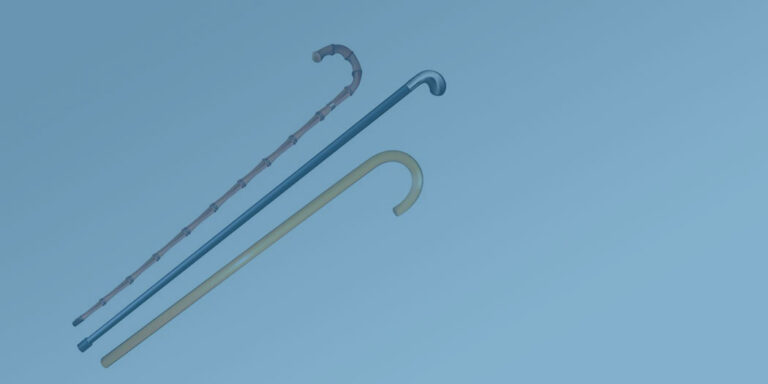Walking Stick vs. Cane? What is the Difference?
A walking stick does not serve well as a permanent mobility aid. A walking cane provides more stability and safe SUPPORT. And in the end, safety comes first.
Getting a walking stick will help you walk comfortably. On the other hand, a cane would be appropriate if you had back pain or leg pain.
- Walking sticks and walking canes differ in their functionality.
- Walking canes are long-term mobility devices that relieve pressure on your leg joints and aid in balance.
- Walking sticks provide temporary stability and footing when walking on rough terrain.
If you need walking assistance, occasionally or long-term, you have multiple options.
There are two most commonly used devices: walking sticks and canes.
So how do you know which is the right choice for your NEEDS?
Let’s talk about walking sticks vs. canes and what each type of aid offers in terms of usage and support.
What Are Walking Sticks?
A walking stick is used for SHORT-TERM walking assistance.
Walking sticks are considered accessories rather than medical assistance devices or mobility aids like a cane.
Compared to canes, walking sticks cannot bear weight for extended periods.
On the stick, the grip is vertical, and on the cane, there are many grip options available.
Walking sticks are used mainly for guiding you through dense or debris-packed pathways.
That makes them excellent tools for hikers, sight-impaired individuals, and anyone who needs balance as they walk.
Wooden Walking Sticks
One of the most romanticized outdoor equipment is the immortal wooden walking stick.
Often seen on short hiking trips, these sticks are typically fine-grain wood.
But the wooden walking sticks have that special NOSTALGIC and NATURAL feel, that many hikers prefer (I do!).
Wooden sticks can be made from many types of wood, including oak, chestnut, birch, maple, and more. And they can have great carvings as decoration.
Aluminum or Carbon Walking Sticks
Aluminum is lightweight compared to a wooden stick, and carbon is ultralight.
These are much more technical than wooden sticks.
But something is missing. And it is that natural feeling of a wooden stick.
But back to technical parts.
Aluminum or carbon walking sticks usually have a removable tip (rubber or sharp metal). A sharp tip helps for navigating rough terrain.
They usually have a cork or rubber handle, and a wrist strap.
These walking sticks are commonly used for trekking rough and intense terrain. You can use one or two depending on the terrain and your needs.
Most poles are telescopic, which makes them easy to store and pack.
Some models resemble wooden sticks in that they are heavier and sturdier. The majority of lightweight carbon models are intended for longer hikes and can even be used for trail running.
Types of Canes and Their Uses
A walking cane is an excellent tool for anyone that needs extra stability and support daily.
Canes are built for long-term use and there are different types of canes for different needs.
Each assistive device has unique functions for different types of support, so you can determine which is right for you.
Canes are an excellent option for anyone who needs extra assistance, whether they are recovering from medical procedures or need a more permanent solution.
Standard Canes
The most popular and common type of cane is the standard cane. Standard types are usually made from aluminum or wood and often use a curved handle.
Standard canes can be great when you need to BALANCE yourself, but they are not preferable for long-term weight-bearing use.
Most people like to use standard canes when running errands, such as grocery shopping, getting their banking done, or visiting a doctor’s office.
These canes are great for first-time users or as secondary or emergency backup canes.
Offset Canes
If you’ve ever been in a long line at the bank and wished you had more support, an offset cane may be a better fit for you.
Offset canes are similar to standard canes, except they offer more support and stabilization.
These canes feature a functional grip handle that helps you GRASP more evenly, especially if you have fatigue or weakness in your hands.
Offset canes are a great option when you have arthritis or joint pain, as they can reduce the impact of standing for long periods.
Quad Canes
Another excellent option for joint pain sufferers is the multi-legged cane, which often has four prongs, or legs, at the base that helps stabilize the device.
These canes also feature handles similar to offset canes, with a cushioned grip and T-handle.
Quad canes are perfect if you enjoy more independence, as they are the most stable option.
When you are ready to sit down, these canes can STAND upright on their own, eliminating the need to use walls or other objects to prop them up.
The balance feature reduces accidents stemming from upturned and fallen canes.
Which Support Device Should You Use? Walking Stick or Cane?
Many factors can weigh in on which mobility assistant you require, including balance, weight support, ease of use, and overall comfort.
Balance
Both walking sticks and canes offer varying degrees of balance.
If you are going for a short walk or hiking a trail, walking sticks are beneficial.
With a wooden stick, you have that natural feeling. With aluminum or carbon ones, you have adjustable length, hand loop, and sharp tip making them ideal for uneven terrain.
Canes also give the user a sense of balance, especially if you opt for a quad cane design that offers more stability than any other type of cane.
Weight Support
If you need more aid to assist with weight support, mobility aids such as canes win out over walking sticks.
Offset and quad canes provide the most support when taking on the additional strain.
Usability and Comfort
Walking canes come in several varieties, making it easier to tailor your needs to your device.
Standard canes make great short-term, everyday walking assistants.
Walking sticks can also be suitable for everyday use if you don’t need that much support (or feel too embarrassed to use a cane).
Offset and quad canes come in handy for more ROBUST tasks that require strength and stability.
You can always customize your cane with padded grips and table holders.
Style and Color
Speaking of customizing your device, canes and walking sticks come in an array of many COLORS and finishes. Some of them can also be considered fashion items.
You can find beautiful wooden canes handcrafted by artisans if wooden is what you are looking for. The wood is typically carved with beautiful patterns.
Canes can also be personalized by adding different colors and patterns to the shaft.
You can also use ergonomic handles if needed.
Finding the Perfect Fit
Ultimately, finding the right aid may take some trial and error.
If one mobility device doesn’t have everything you are looking for, it may be best to try another.
Having several assistive devices at your disposal can benefit you.
Remember that walking sticks are an excellent tool for balancing and treading your way through heavy terrain. But it isn’t a good option for those who need something more stable and weight-bearing.
Canes come in several varieties and are an excellent fit for those recuperating after medical operations. Or anyone in need of a long-term and reliable solution.
Here you will find more detailed information about the different types of walking canes.
What is the point of using a wooden walking stick? This video illustrates it nicely:







